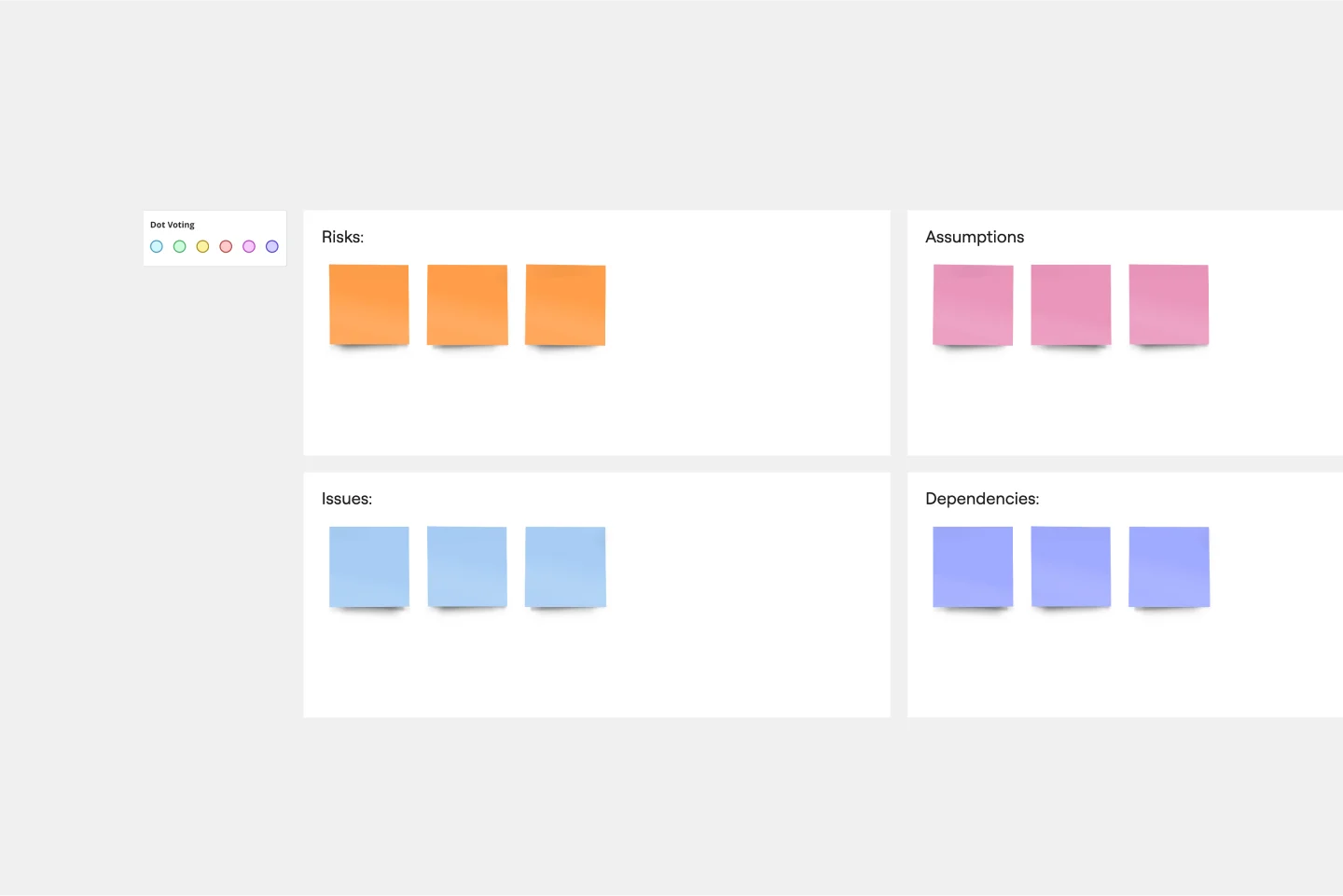Risk Assessment templates
Miro's risk assessment templates help you identify and manage risks effortlessly. Whether you're planning, analyzing, or mitigating, these templates provide a clear structure to evaluate potential challenges, prioritize actions, and ensure successful outcomes.
RAID Log Template
Works best for:
Agile Methodology, Project Management, Agile Workflows
Use the RAID Log template to better understand potential risks, assumptions, issues, and dependencies relating to an upcoming project. With this information, you can make effective contingency plans and prepare your resources accordingly. You’ll know what could go wrong throughout the project and how to fix the problem.
Risk Assessment Template
Works best for:
Leadership, Project Management, Decision Making
Every business faces risk. The more you factor it into your decisions early on, the better prepared you’ll be to avoid, absorb, or mitigate the risks you encounter. Use Miro’s risk assessment template to collaborate on a clear-eyed risk assessment that ensures you’ll never be caught unawares.
Risk Matrix Template
Works best for:
Leadership, Decision Making, Strategic Planning
A risk matrix--also known as a probability matrix, risk assessment matrix, or impact matrix--is a tool that allows you to evaluate overall risk by visualizing potential risks in a diagram. The tool allows you to weigh the severity of a potential risk against the probability that the risk might occur. Risk matrices are useful for risk management because they visually represent the risks involved in a decision. This empowers you to avoid worst-case scenarios by preparing contingencies or mitigation plans.
Join thousands of teams collaborating and doing their best work on Miro.
Sign up freeAbout the Risk Assessment Templates Collection
Risk assessment is a crucial process for identifying, evaluating, and mitigating potential risks in various projects and operations. Our risk assessment templates offer a comprehensive suite of tools designed to help teams systematically approach risk management. These templates include the risk assessment plan template and the risk assessment matrix template, which are tailored to simplify the risk evaluation process and ensure thorough analysis.
Why you'll love our risk assessment templates
Using Miro's risk assessment templates brings many benefits, especially for beginners new to risk management. Here are some detailed advantages:
Structured approach: The templates provide a clear, step-by-step framework for conducting risk assessments, ensuring no critical aspect is overlooked.
Time efficiency: Pre-designed templates save time by eliminating the need to create risk assessment documents from scratch.
Consistency: Standardized templates ensure that all team members follow the same process, leading to consistent and reliable risk assessments.
Visualization: Miro's visual tools make it easy to map out risks and their potential impacts, enhancing understanding and communication among team members.
Collaboration: The templates are designed for collaborative use, allowing multiple team members to contribute and review the risk assessment in real time.
Customization: Users can easily customize the templates to fit the specific needs of their projects or industries.
How to use the risk assessment templates in Miro
Using Miro's risk assessment templates is straightforward and user-friendly. Follow these steps to get started:
Access the template: Navigate to the Miro template library and select the risk assessment template that best suits your needs.
Define the scope: Clearly outline the scope of the risk assessment, including the project or operation being evaluated and the objectives of the assessment.
Identify risks: List all potential risks associated with the project. Use the template to categorize these risks based on their nature (e.g., financial, operational, strategic).
Evaluate risks: Assess the likelihood and impact of each identified risk. The risk assessment matrix template can help visualize this evaluation by plotting risks on a matrix based on their severity and probability.
Develop mitigation strategies: For each significant risk, develop strategies to mitigate or manage the risk. Document these strategies in the risk assessment plan template.
Review and update: Regularly review and update the risk assessment to reflect any changes in the project or new risks that may arise. Miro's collaborative features make it easy to keep the document current and involve all relevant stakeholders.
By following these steps, teams can effectively manage risks and ensure their projects are well-prepared to handle potential challenges. Miro's risk assessment templates empower teams to thrive by providing thorough and efficient risk management tools.
